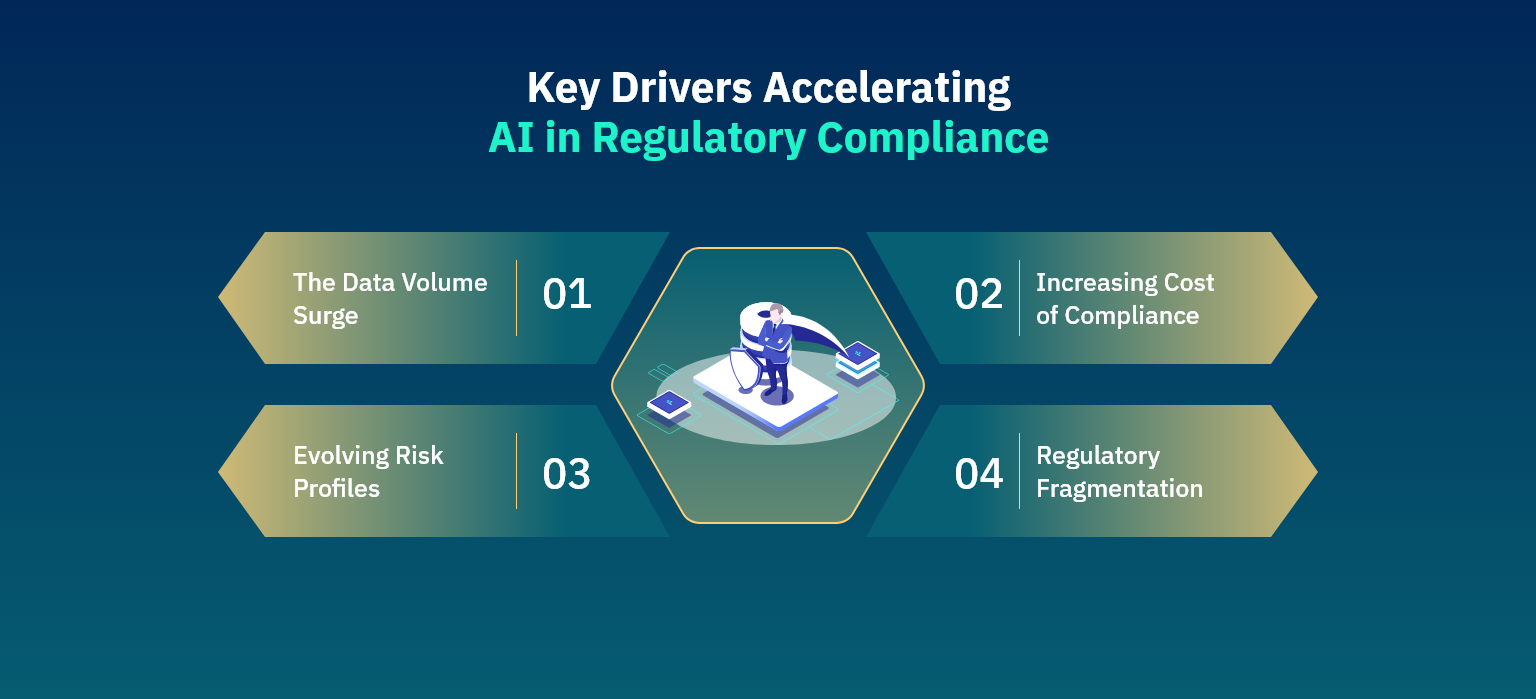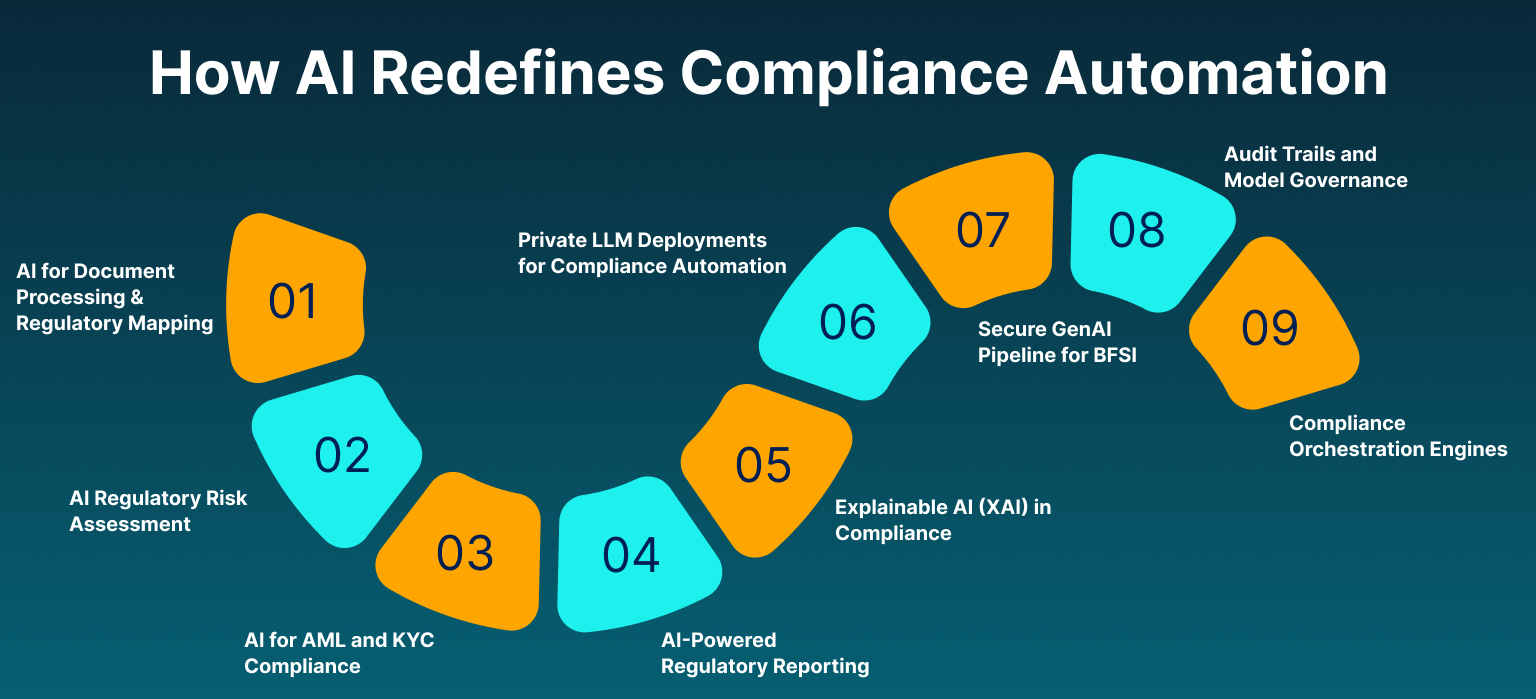
Executive Summary
Regulatory compliance in the Banking, Financial Services, and Insurance (BFSI) sector has become one of the most resource-intensive and risk-sensitive functions. Banks commonly assign 10 to 15% of their full-time workforce solely to Know Your Customer (KYC) and Anti-money laundering (AML) processes [1]. Yet automation rates remain low due to fragmented data resources and unstandardized data sets.
The outcome is inefficiency on both sides: compliance teams lose valuable time on manual tasks while clients experience slow, repetitive, and often frustrating onboarding and verification journeys.
This is where intelligent Regulatory Technology (RegTech) platforms are redefining compliance. By integrating AI-driven regulatory change management, automated risk assessment, and intelligent reporting, BFSI enterprises are moving from reactive compliance to proactive oversight. More than just efficiency, this shift brings resilience, scalability, and transparency.
Matellio brings deep expertise in designing and implementing AI-powered RegTech and Supervisory Technology (SupTech) solutions for BFSI institutions and regulatory agencies. Our approach combines regulatory technology with practical implementation experience, as demonstrated through Ecuador’s national Superintendencia de Economía Popular y Solidaria (SEPS) case study—where we developed a comprehensive Financial Consumer Protection Suite featuring automated claims management, multilingual AI chatbot support, real-time analytics dashboards, and secure API-enabled identity verification. We specialize in building compliance platforms that emphasize explainability, auditability, and co-creation with regulators to ensure solutions meet both technical and regulatory requirements while delivering measurable improvements in complaint resolution speed, consumer protection, and supervisory oversight.
As regulatory frameworks continue to grow in complexity across jurisdictions, intelligent RegTech solutions are becoming essential for real-time compliance monitoring, multilingual complaint management, and transparent audit trails.
This blog explores how AI-driven RegTech is reshaping compliance through automation, analytics, and predictive intelligence supported by real-world results from leading implementations.
I. The Changing Dynamics of Regulatory Compliance
n financial services, compliance used to be a static, rules-based function driven by checklists and after-the-fact audits. That approach no longer works. The rise of open banking, digital payments, and cross-border transactions has created an environment where regulatory updates occur weekly, not yearly.
Key industry trends intensifying compliance pressure include:
- Expanding data protection laws such as GDPR, CCPA, and Brazil’s LGPD
- Cross-border operational risks in payments, fintech, and digital lending
- Growing consumer protection expectations and faster complaint handling timelines
- Evolving anti-money laundering (AML) and KYC regulations that require real-time verification
Legacy systems and manual reviews cannot keep up with the volume, speed, and complexity of these changes. Compliance teams need AI-enabled tools capable of interpreting regulatory text, automating documentation, and providing real-time risk alerts to mitigate exposure before incidents occur.
II. What Defines an Intelligent RegTech Platform
Intelligent RegTech platforms combine AI, machine learning (ML), robotic process automation (RPA), and natural language processing (NLP) to automate and optimize compliance activities. Unlike rule-based software, these systems continuously learn from data and adjust compliance workflows dynamically.
Core capabilities include:
| Function | AI Capability | Key Impact |
|---|---|---|
| Regulatory Change Management | NLP to interpret new regulations and compare with internal policies | Faster adaptation to new laws |
| Compliance Monitoring | ML algorithms to detect anomalies in transactions or operations | Early identification of risks |
| Reporting and Audit Automation | RPA for report generation and submission | Reduced manual errors |
| KYC and AML Verification | AI-driven document and identity checks | Faster onboarding with higher accuracy |
| Complaint Management | NLP and chatbots for multilingual support | Improved customer transparency and responsiveness |

Together, these technologies enable predictive, explainable, and auditable compliance ecosystems.
III. Key Drivers Accelerating AI in Regulatory Compliance
A mix of regulatory pressure, operational inefficiency, and technological opportunity drives the growing urgency to modernize compliance operations. Several key factors are accelerating the adoption of AI in regulatory compliance across the BFSI sector:
1.The Data Volume Surge :
Financial institutions handle millions of transactions daily. Manual compliance teams cannot process this volume in real time. AI models can process structured and unstructured data simultaneously, performing continuous checks that human analysts would take weeks to complete.
The shift is already happening at scale. Gartner predicts that by 2025, over 50% of major enterprises will rely on AI and machine learning for continuous regulatory compliance monitoring—a sharp rise from less than 10% in 2021 [6]. This acceleration reflects how organizations are responding to transaction volumes that manual processes simply cannot handle.
2.Increasing Cost of Compliance :
Compliance costs have surged, consuming much of banks’ discretionary budgets. Operating expenses for compliance are over 60% higher than pre-crisis levels [2], while regulators have issued more than $45 billion in AML and sanctions fines since 2000 [3]. Intelligent RegTech and SupTech solutions automate repetitive tasks, freeing human analysts for higher-value interpretation and strategy.
For organizations already using AI in compliance, the business case is clear. According to White & Case’s 2025 global compliance survey, 73% cite time savings and 71% cite cost savings as their primary drivers for adoption [7]. Industry research from Strategy& demonstrates the potential scale of these savings: RegTech implementations can reduce compliance costs by 30% to 50% [8], a significant impact given that financial institutions collectively spend over $60 billion annually on compliance operations.
3.Evolving Risk Profiles
Fraud, cybercrime, and insider threats now require real-time pattern recognition rather than retrospective review. AI models can detect anomalies and flag potential violations based on behavioral analytics instead of static thresholds.
The efficiency gains are transforming how compliance teams operate. Middesk’s 2024 industry analysis found that 37.6% of businesses have automated more than half of their compliance-related tasks, with nearly 38% cutting compliance task time by over 50% [9]. This shift allows teams to move from reactive task completion to proactive threat hunting and strategic risk assessment.
4.Regulatory Fragmentation
Multinational financial firms must navigate diverse regulatory ecosystems. AI-enabled platforms standardize compliance interpretation across jurisdictions, providing consistent oversight while reducing localization costs.
The complexity of managing compliance across borders is driving significant investment in technology solutions. Grand View Research projects the global RegTech market will expand from USD 17.02 billion in 2023 to USD 70.64 billion by 2030, representing a 23.1% compound annual growth rate [10]. This rapid market expansion underscores how financial institutions worldwide view AI-powered RegTech as essential infrastructure for managing fragmented regulatory landscapes.
IV. How AI Redefines Compliance Automation
AI moves compliance functions from manual, reactive processes to intelligent, data-driven systems that anticipate and mitigate risks in real-time. AI-driven SupTech solutions are helping regulators more effectively supervise financial institutions by providing automated tools for monitoring and enforcement. These technologies enable regulators to conduct real-time surveillance, analyze large datasets, and predict potential risks, allowing for smarter, more proactive decision-making. The following are key areas where AI is creating a measurable impact in compliance automation.
1.AI for Document Processing and Regulatory Mapping:
AI models extract and classify clauses, obligations, and reporting requirements from lengthy regulatory documents. This capability streamlines policy mapping and version control, eliminating human bottlenecks.
2.AI Regulatory Risk Assessment
By combining historical compliance data with transaction-level insights, ML algorithms predict potential non-compliance events before they occur. Predictive analytics help compliance officers prioritize reviews and allocate resources effectively.
3.AI for AML and KYC Compliance
Automated identity verification, biometric validation, and anomaly detection in fund transfers enhance fraud detection while reducing false positives. Using AI-powered AML monitoring, HSBC reported identifying two to four times more suspicious activity while cutting false positives by up to 60% [4], [5].
4.AI-Powered Regulatory Reporting
RPA and AI together generate dynamic compliance reports with audit-ready trails. These reports can be automatically updated as new data streams in, providing real-time compliance visibility to regulators and executives.
5.Explainable AI (XAI) in Compliance
Explainable AI makes algorithmic decisions interpretable to regulators. This transparency is crucial for BFSI institutions, where accountability and auditability determine trustworthiness. XAI provides visibility into model reasoning, such as why a transaction was flagged or an account was frozen, ensuring fairness and governance compliance.
6.Private LLM Deployments for Compliance Automation
Private LLM deployments focus on extracting valuable insights from large volumes of unstructured data, such as contracts, legal texts, and regulatory documents. This AI-driven approach automates the extraction of compliance-related information from existing documentation, enabling businesses to maintain up-to-date regulatory knowledge without manually sifting through extensive texts. With secure, private deployments, organizations ensure that sensitive data remains protected while benefiting from advanced AI capabilities.
7.Secure GenAI Pipeline for BFSI
A secure Generative AI (GenAI) pipeline for BFSI (Banking, Financial Services, and Insurance) ensures that compliance data is handled with the highest level of security. By integrating AI into the regulatory workflow, financial institutions can quickly generate secure documents, compliance reports, and financial statements while adhering to strict data protection regulations. This pipeline ensures that AI-generated outputs meet industry standards for security, privacy, and compliance.
8.Audit Trails and Model Governance
With AI in compliance, maintaining an audit trail is critical for ensuring transparency and accountability. AI systems automatically generate logs of decisions and actions, creating an immutable record of every step in the compliance process. This enhances model governance, providing a clear framework for reviewing and validating decisions, ensuring that AI models are compliant with both internal policies and external regulations.
9.Compliance Orchestration Engines
Compliance orchestration engines integrate multiple compliance functions, such as regulatory monitoring, risk assessment, document processing, and reporting, into a unified system. AI-powered orchestration enables financial institutions to manage complex regulatory requirements more efficiently. These engines coordinate various compliance tasks and workflows, ensuring that compliance teams can respond quickly and effectively to changing regulations, minimizing risk and improving operational efficiency.

The growing adoption of AI-driven RegTech is best illustrated through real-world success. One such example comes from Ecuador, where national regulators used AI to modernize consumer protection and compliance oversight.
SEPS: Ecuador’s National RegTech Transformation
Challenge
Ecuador’s financial regulator, SEPS, struggled with slow claim processing, fragmented compliance tracking, and limited consumer support. Manual workflows led to delays and inconsistent supervision, leaving financial institutions with little visibility into consumer protection performance.
Solution
In collaboration with Cambridge SupTech Lab and the World Bank, Matellio developed a Financial Consumer Protection Suite powered by AI automation and analytics.
Key features include:
- The Claims Management System (CMS) automated submission and tracking.
- A multilingual AI chatbot in Spanish handled real-time inquiries and case escalations.
- A data analytics dashboard provided real-time insights into compliance performance and emerging risks.
- Integration with SEPS’ Civil Registry API ensured secure identity verification and regulatory adherence.
Results
- 40% faster complaint resolution
- Thousands of consumer inquiries managed autonomously
- Real-time supervision and analytics-based oversight
- Secure, API-enabled identity validation
- Stronger financial consumer protection through automation
This initiative shows how AI-powered RegTech can turn compliance from reactive enforcement into continuous, data-driven regulation. This model is increasingly relevant for financial authorities worldwide.
| From | To | How | Quantifiable Impact |
|---|---|---|---|
| Reactive Monitoring | Predictive Oversight | AI enables continuous monitoring and predictive alerts that anticipate non-compliance rather than merely documenting it. | Gartner reports over 50% of major enterprises will use AI for continuous compliance monitoring by 2025 ; organizations implementing AI-driven continuous monitoring reduce compliance incidents by up to 45% [11] |
| Manual Documentation | Smart Workflows | Automated document extraction and classification frees teams from repetitive work, allowing them to focus on interpretation and decision-making. | Audit preparation time reduced by 70% or more [12]; AI-powered compliance tools reduce manual review time by up to 75% [13]; generative AI processes cases up to 70% faster through automated categorization [14] |
| Reporting | Insight Generation | AI systems not only compile reports but also identify hidden trends, helping compliance leaders influence product design and risk frameworks. | False positives reduced by up to 60% (as demonstrated by HSBC’s implementation) ; machine learning algorithms achieve fraud detection rates between 87-94% while reducing false positives by 40-60% [15] |
| Compliance Cost Center | Value Driver | Modern RegTech platforms reposition compliance as a strategic differentiator. Institutions with real-time compliance insights build stronger trust with regulators and customers, gaining a competitive advantage. | 30–50% reduction in compliance costs ; time spent on regulatory tasks reduced by up to 80% [16]; organizations save an average of $3.05 million per data breach when using comprehensive AI and automation [17] |
As compliance becomes more predictive and data-driven, AI’s role moves beyond automation into strategic enablement. Once compliance systems start generating actionable insights, the next step is to use those insights for proactive risk prevention.
This is where predictive analytics and robotic process automation (RPA) come together to connect continuous monitoring with automated execution, creating a smarter and more responsive compliance ecosystem.
VI. The Role of RPA and Predictive Analytics in Regulatory Compliance
Predictive analytics combined with RPA allows compliance teams not only to detect but also to prevent non-compliance. For example:
- Predictive models analyze transaction data to forecast AML risks before suspicious activity occurs.
- RPA bots automate repetitive filing and reporting tasks, minimizing human error.
- Machine learning algorithms learn from historical audits to flag potential issues in near real time.
These systems work best when they integrate seamlessly with core banking, CRM, and ERP systems to create a single compliance intelligence layer across the organization.
VII. Real-Time Compliance Monitoring and Multilingual Support
Predictive analytics and RPA establish the foundation for intelligent, automated compliance. Yet, as financial institutions expand across markets, real-time visibility and multilingual engagement become equally important.
To maintain consistency across jurisdictions and languages, organizations are now extending these AI capabilities into real-time compliance monitoring and consumer interaction. As a result, oversight remains both global in scope and locally relevant.
AI-driven chatbots and NLP models enable BFSI institutions to:
- Offer multilingual consumer support with consistent accuracy
- Monitor regional compliance requirements through automated translation and interpretation of regulatory texts
- Provide instant resolution status and case updates across jurisdictions
VIII. Explainable AI (XAI) and the Future of Regulatory Governance
Explainable AI in compliance will define the next phase of RegTech evolution. As regulators begin scrutinizing algorithmic governance, transparency and interpretability become non-negotiable
XAI models clarify how conclusions are reached, whether it is classifying a transaction as suspicious or rejecting a document. This transparency strengthens regulator confidence and builds institutional accountability.
In the coming years, expect convergence between AI auditability, model risk governance, and automated compliance assurance, setting the foundation for continuous, regulator-ready reporting.
IX. The Road Ahead: Intelligent Compliance as a Competitive Advantage
The shift toward AI-powered real-time compliance monitoring ecosystems is already underway. Firms that embrace intelligent RegTech platforms now will gain measurable advantages: faster response to regulatory changes, reduced compliance overhead, improved consumer trust, and stronger market reputation.
The differentiator will not be whether an organization adopts AI, but how responsibly and transparently it operationalizes it.
X. How Matellio Addresses RegTech Transformation
Matellio has been at the forefront of designing AI and analytics-driven compliance solutions tailored to BFSI and regulatory agencies. By focusing on explainable AI, real-time compliance monitoring, and multilingual complaint automation, Matellio enables institutions to modernize compliance without disrupting existing workflows.
The SEPS national RegTech initiative is one such real-world case of how an integrated approach to AI automation, analytics, and chatbot-driven consumer interaction can revolutionize complaint management and regulatory oversight.
Matellio’s model emphasizes co-creation with regulators, ensuring solutions remain auditable, secure, and transparent. These are key priorities for future-ready RegTech ecosystems.
Key Takeaways
- Compliance is evolving from reactive to predictive: AI enables continuous monitoring and proactive risk management across BFSI functions.
- Intelligent RegTech reduces operational overhead: Automation and analytics free compliance teams from manual documentation and repetitive audits.
- Explainable AI will drive regulator confidence: Transparency and interpretability are essential for sustainable AI integration in compliance.
- Real-time monitoring creates strategic agility: Institutions can adapt instantly to regulatory changes across multiple jurisdictions.
- AI-driven RegTech is becoming a strategic differentiator: Organizations adopting AI responsibly will lead in compliance efficiency, trust, and governance.
FAQ’s
AI significantly reduces operational costs and compliance risk through automation, but it introduces the need for model governance. Institutions that implement clear validation frameworks can achieve cost savings without added complexity.
AI automates data extraction, document classification, and transaction analysis. This generates real-time compliance alerts and dynamic regulatory reports that minimize manual intervention.
Intelligent RegTech platforms enable continuous monitoring, predictive insights, and explainable reporting. They replace manual, retrospective reviews with proactive compliance intelligence.
NLP engines analyze new regulations, map them to internal policies, and update workflows instantly, while ML models assess risk exposure based on live transaction patterns.
Explainable AI provides visibility into algorithmic decisions, making them auditable and regulator-friendly. It ensures fairness, accountability, and trust in AI-driven compliance ecosystems.
References:
[1] McKinsey & Company, How agentic AI can change the way banks fight financial crime
2] Deloitte, Cost of Compliance and Regulatory Productivity
[3] Financial Crime News, Bank & FI AML/Sanctions Fines & Penalties in the 21st Century
[4] PR Newswire, Google Cloud Launches AI-Powered Anti Money Laundering Product for Financial Institutions
[5] HSBC, Harnessing the power of AI to fight financial crime
[6] Censinet, Why Most GRC Tools Fail in Healthcare – And What Comes Next (citing Gartner)
https://censinet.com/perspectives/why-most-grc-tools-fail-in-healthcare-and-what-comes-next
[7] White & Case, Artificial intelligence in the compliance function – 2025 Global Compliance Risk Benchmarking Survey
https://www.whitecase.com/insight-our-thinking/2025-global-compliance-risk-benchmarking-survey-artificial-intelligence
[8] Strategy& (PwC), How RegTech can turbocharge economic transformation
https://www.strategyand.pwc.com/m1/en/strategic-foresight/sector-strategies/media/future-of-compliance/future-of-compliance.pdf
[9] Middesk, How AI and automation are reshaping the compliance landscape – 2024 Wrapped Report
https://www.middesk.com/blog/how-ai-and-automation-are-reshaping-the-compliance-landscape
[10] Grand View Research, RegTech Market Size, Share, Growth | Industry Report, 2030
https://www.grandviewresearch.com/industry-analysis/regulatory-technology-market
[11] Avatier, Compliance Risk: AI-Driven Assessment of Regulatory (citing Deloitte)
https://www.avatier.com/blog/compliance-risk-ai-driven/
[12] DeepTempo, The Compliance Technology Stack: Automating Audit Readiness
https://www.deeptempo.ai/blogs/the-compliance-technology-stack-automating-audit-readiness
[13] BPR Hub, Automation in Compliance Documentation: Making Things Easier (citing McKinsey)
https://www.bprhub.com/blogs/automation-in-compliance-documentation
[14] CycoreSecure, How AI Is Changing Compliance Automation: 2025 Trends & Stats
https://cycoresecure.com/blogs/how-ai-is-changing-compliance-automation-2025-trends-stats
[15] Journal of Financial Innovation, The Role of AI in Fraud Detection: Are financial institutions using the right tools?
https://jfi-aof.org/index.php/jfi/article/download/10086/9111/35685
[16] Codiste, AI in Fintech 2025: Use Cases, Compliance & Customer Experience
https://www.codiste.com/fintech-ai-use-cases-compliance-cx
[17] IBM Security, Cost of a Data Breach Report 2024
https://www.ibm.com/reports/data-breach



